Saturday Ė Windows, Fiery Furnace
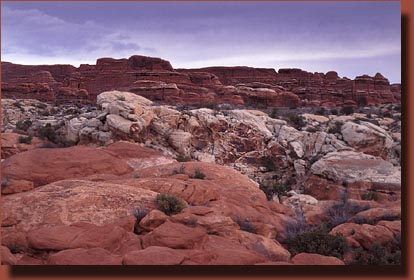 In
the predawn glow, my headlights lit up the pavement and the red sand on
either side as I again motored my gasoline vehicle up the steep road past
the park entrance into the netherland to the north. Darkness shrouded everything,
and I was only dimly confident that the sky was clouded over, but hoping
it was not so. Up the winding road we drove, Andra and I, catching faint
glimpses of otherworldy rock domes and spires. I found the spot on the
road I was seeking, pulled off into an approved pull-out and stopped the
engine. At once, silence. The air was still, and dark. The pavement was
wet. When I stepped out of the car and into the cool, moist air, I instantly
knew there was not likely to be any viewing of the sun this morning. I
got back in the car to warm myself. Andra began to nod off in the passenger
seat under this lack of any external stimulous. Beyond the car was mostly
blackness. I sat patiently, watching the outlines of rock formations and
dormant bitterbrush grow imperceptibly more clear as the heavy clouds to
the east began to transmit their cold blue filtered light across the miles
of rolling rock. I expected the sun to greet us around 7. At 7, all
that could be seen in the sky in any direction was the smooth haze of grey
water droplets. I walked briefly down the road and back, switching sides,
examining the dormant vegetation all soaking up water in preparation for
the big spring campaign. The smallish shrubs were spaced generously, with
wide interstitial space that, on the whole, represented a landscape In
the predawn glow, my headlights lit up the pavement and the red sand on
either side as I again motored my gasoline vehicle up the steep road past
the park entrance into the netherland to the north. Darkness shrouded everything,
and I was only dimly confident that the sky was clouded over, but hoping
it was not so. Up the winding road we drove, Andra and I, catching faint
glimpses of otherworldy rock domes and spires. I found the spot on the
road I was seeking, pulled off into an approved pull-out and stopped the
engine. At once, silence. The air was still, and dark. The pavement was
wet. When I stepped out of the car and into the cool, moist air, I instantly
knew there was not likely to be any viewing of the sun this morning. I
got back in the car to warm myself. Andra began to nod off in the passenger
seat under this lack of any external stimulous. Beyond the car was mostly
blackness. I sat patiently, watching the outlines of rock formations and
dormant bitterbrush grow imperceptibly more clear as the heavy clouds to
the east began to transmit their cold blue filtered light across the miles
of rolling rock. I expected the sun to greet us around 7. At 7, all
that could be seen in the sky in any direction was the smooth haze of grey
water droplets. I walked briefly down the road and back, switching sides,
examining the dormant vegetation all soaking up water in preparation for
the big spring campaign. The smallish shrubs were spaced generously, with
wide interstitial space that, on the whole, represented a landscape 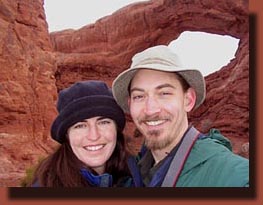 more
of dirt and rock than shrub cover. For some far-off cosmic reason, the
thought of global-warming-induced climate change popped into my head, and
I wondered how the surrounding vegetation would change with the predicted
10 degree rise in mean global temperature by 2100. Would there be more
shrubs? Fewer? Would the shrubs give way to mighty pine forests as the
jet stream dipped further south with the melting of the polar ice caps?
On the heels of that thought followed this comforting thought: No matter
what the temperature does in this century or in the next thousand, these
rocks will stand here, much like they do now, past all lives of men. These
red sandstone mesas and cliffs will outlast us just as surely as the oceans
will, until the sun consumes the planet and everything starts over. Mankind
will degenerate by the billions into warring, desperate creatures, fighting
over water sources and the last productive croplands, but these rocks will
remain, minus a few millimeters of sand. This is comforting to me, anyway,
to know that there are yet a few items in the world that man cannot readily
destroy. For now, anyway. more
of dirt and rock than shrub cover. For some far-off cosmic reason, the
thought of global-warming-induced climate change popped into my head, and
I wondered how the surrounding vegetation would change with the predicted
10 degree rise in mean global temperature by 2100. Would there be more
shrubs? Fewer? Would the shrubs give way to mighty pine forests as the
jet stream dipped further south with the melting of the polar ice caps?
On the heels of that thought followed this comforting thought: No matter
what the temperature does in this century or in the next thousand, these
rocks will stand here, much like they do now, past all lives of men. These
red sandstone mesas and cliffs will outlast us just as surely as the oceans
will, until the sun consumes the planet and everything starts over. Mankind
will degenerate by the billions into warring, desperate creatures, fighting
over water sources and the last productive croplands, but these rocks will
remain, minus a few millimeters of sand. This is comforting to me, anyway,
to know that there are yet a few items in the world that man cannot readily
destroy. For now, anyway.
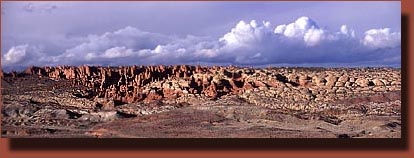
|
I hopped back in the car after this communion
with the vegetation and started the engine, drove further up the road to
the pullout for Balanced Rock. Andra and I donned our raincoats to keep
out the steady drizzle that was then falling, and began walking slowly
along the approved Park Service Trail, stopping to read about "Chip off
the Old Block", a smaller balanced rock that became disbalanced in 1976.
At the end of the trail, we watched 3 white tailed deer grazing on the
shrubs about 100 yards away. They picked up their heads, kept chewing,
and then after a minute or so, trotted further away into obscurity among
the folds of rock. We continued our tour of the Balanced Rock by following
the muddy "primitive" trail around the north side. A cottontail, his coat
shining iridescently against the drab wet sand, crouched still as rock
just off the trail, hoping not to be seen. We stood and watched him long
enough that he must have felt our gaze, and suddenly bolted directly away
from us, disappearing almost instantly. Andra described the Balanced Rockís
resemblance to a Tyrannosaurus Rex from a particular angle, even down to
what the terrible lizard was thinking as he posed thus. Back at the beginning
of the short loop, with drizzle giving way to drier skies, we sat back
down into the plush automobile seats and drove off again, this time towards
the Windows Section.
Several cars were already parked and empty when
we arrived. The giant trail that led up to the large Window arches beckoned
us and we followed. Unidentifiable voices were occasionally heard echoing
off the cliffs, but no humans could be seen. We passed by three of the
largest arches in the parkÖTurret, South Window and North Window. At the
end of the groomed trail 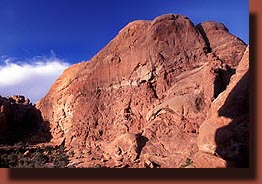 by
South Window, another "primitive" loop trail began, and we took this around
to the east side of the wall in which the Window arches were carved. Away
in the distance, the La Sal Mountains were still shrouded in clouds. The
tops of those peaks rise up past 13,000 ft. The arches we stood next to
were somewhere around 5,000 ft, and yet the mountains looked as if they
were almost on a level plain with where we stood. The foot path eventually
snaked its way over wet sand and slickrock back to the parking lot where
two women and a man with tripods and cameras and bags of equipment were
setting up for shots of the arches. The man was laboring under a frame-pack
sized bag of gear, presumably camera equipment, whilst carrying his extended
tripod and camera in his hands. This was the first of what became a very
common site on the trip: very serious amateur and professional photographers
with carloads of equipment and a complete lack of regard for other visitors.
Though a little odd, the presence of massive amounts of photographic equipment
was not a matter for second thoughts, after all I too was carrying my own
humble camera over my shoulder. In the park there seemed to be two groups:
quiet hikers and bombastic photographers. by
South Window, another "primitive" loop trail began, and we took this around
to the east side of the wall in which the Window arches were carved. Away
in the distance, the La Sal Mountains were still shrouded in clouds. The
tops of those peaks rise up past 13,000 ft. The arches we stood next to
were somewhere around 5,000 ft, and yet the mountains looked as if they
were almost on a level plain with where we stood. The foot path eventually
snaked its way over wet sand and slickrock back to the parking lot where
two women and a man with tripods and cameras and bags of equipment were
setting up for shots of the arches. The man was laboring under a frame-pack
sized bag of gear, presumably camera equipment, whilst carrying his extended
tripod and camera in his hands. This was the first of what became a very
common site on the trip: very serious amateur and professional photographers
with carloads of equipment and a complete lack of regard for other visitors.
Though a little odd, the presence of massive amounts of photographic equipment
was not a matter for second thoughts, after all I too was carrying my own
humble camera over my shoulder. In the park there seemed to be two groups:
quiet hikers and bombastic photographers. 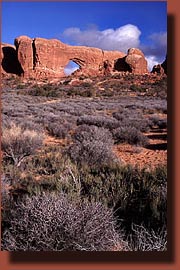 What
I came to notice was that while many people were walking the trails and
respecting the posted signs to restrict walking to trail or solid rock,
the photographers, almost without fail, were the ones walking right through
the shrubflats, crushing cryptobiotic crust and trampling delicate forbs
and grasses in their zeal for the perfect shot. The hikers were generally
a quiet bunch, but anyone toting a tripod and a filter bag felt compelled
to talk in voices heard for a hundred yards. There is no rule or guideline
regarding noise in a park, save common sense. Several photographers set
up on a rock near Turret Arch that evening and talked with others via CB
radio, turned up to a volume clearly audible from the South Window. He
had the CB attached to his belt, and was shouting into the air so that
the person on the other end could hear him. Most of the photographers did
not seem to be there to enjoy the park, but only to take from the park
trophies for later display. Like the urban cowboy who flies into Wyoming
for a week each year to "bag an elk" these people seemed to be wholly What
I came to notice was that while many people were walking the trails and
respecting the posted signs to restrict walking to trail or solid rock,
the photographers, almost without fail, were the ones walking right through
the shrubflats, crushing cryptobiotic crust and trampling delicate forbs
and grasses in their zeal for the perfect shot. The hikers were generally
a quiet bunch, but anyone toting a tripod and a filter bag felt compelled
to talk in voices heard for a hundred yards. There is no rule or guideline
regarding noise in a park, save common sense. Several photographers set
up on a rock near Turret Arch that evening and talked with others via CB
radio, turned up to a volume clearly audible from the South Window. He
had the CB attached to his belt, and was shouting into the air so that
the person on the other end could hear him. Most of the photographers did
not seem to be there to enjoy the park, but only to take from the park
trophies for later display. Like the urban cowboy who flies into Wyoming
for a week each year to "bag an elk" these people seemed to be wholly 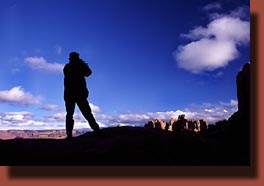 disconnected
from reality. Most of the photographers seemed to be clinging to the urban
world, observing the wild from afar rather than observing it up close and
intimately. Folks visiting places of beauty should spend less time talking
and more time observing what theyíve traveled so far to see, in my own
humble opinion. Observation includes much more than sight; it also includes
listening, touching, smelling and feeling the place. Now I donít care a
bit what others get out of their visit to a place like this, but I care
a great deal when my own observation of the natural aspects of an area
are drowned among loud, needless conversations about F-stops and neutral
density filter preferences. Furthermore, and Iím really getting on a high
horse here, how can they hope to take a photograph that captures the essence
of a location when they donít take the time to observe the location and
understand what that essence is? Just snap, snap, snap go the cameras with
their automatic focus motors spinning and whirring, auto-advancing film
at a furious pace, digital beeps indicating focus lock echoing in the quiet
air. Then clack, clack go the legs of the tripod as the camera is scooped
up, folded down and carted to the next spot. Having a camera along on a
hike is great, I encourage it and I do it myself. Taking photography seriously
is great. But using photography as an excuse to be obnoxious is unacceptable.
I take lots of photographs, but I am always quiet and respectful of the
right of others to enjoy the park in quiet contemplation. The pictures
come second. Thus may it always be. To head off the inevitable refrain
of "you think youíre better than they are", Iíll admit to the affirmative
without delay. After all, if I thought they were better, Iíd start acting
like them. disconnected
from reality. Most of the photographers seemed to be clinging to the urban
world, observing the wild from afar rather than observing it up close and
intimately. Folks visiting places of beauty should spend less time talking
and more time observing what theyíve traveled so far to see, in my own
humble opinion. Observation includes much more than sight; it also includes
listening, touching, smelling and feeling the place. Now I donít care a
bit what others get out of their visit to a place like this, but I care
a great deal when my own observation of the natural aspects of an area
are drowned among loud, needless conversations about F-stops and neutral
density filter preferences. Furthermore, and Iím really getting on a high
horse here, how can they hope to take a photograph that captures the essence
of a location when they donít take the time to observe the location and
understand what that essence is? Just snap, snap, snap go the cameras with
their automatic focus motors spinning and whirring, auto-advancing film
at a furious pace, digital beeps indicating focus lock echoing in the quiet
air. Then clack, clack go the legs of the tripod as the camera is scooped
up, folded down and carted to the next spot. Having a camera along on a
hike is great, I encourage it and I do it myself. Taking photography seriously
is great. But using photography as an excuse to be obnoxious is unacceptable.
I take lots of photographs, but I am always quiet and respectful of the
right of others to enjoy the park in quiet contemplation. The pictures
come second. Thus may it always be. To head off the inevitable refrain
of "you think youíre better than they are", Iíll admit to the affirmative
without delay. After all, if I thought they were better, Iíd start acting
like them.
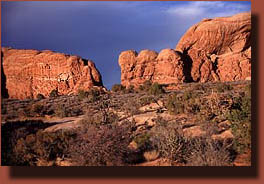 Walking
the opposite direction from the photographers with a mild distaste, Andra
and I crested a small rise that separated one parking lot from another,
then walked down the trail towards the Double Arch, formed by a caved-in
pothole near the cliff face. We reached the arch and sat in silent observation
of the great rock cathedral for several moments before I decided to see
it more up-close-and-personal. Giving in to the urge that seemingly grips
most visitors to the arches, I endeavored to climb up and stand in the
arch. Why? Why not? To try to achieve a more intimate contact with this
strange and mysterious thing of beauty? To labor a little and sweat a drop
so I feel like Iíve earned the view? To feel the rock on my hands? To see
what is on the other side? Who knows? I walked up the smooth slope of solid
rock towards the arch opening to the west, and scrambled a little over
the steep pitches to the point where I could lay down on the rock and just
barely peek through the arch to the ground below, and the unromantic road
with travelling car. Back down the trail, back in the car, up the road
to see whatís next. Walking
the opposite direction from the photographers with a mild distaste, Andra
and I crested a small rise that separated one parking lot from another,
then walked down the trail towards the Double Arch, formed by a caved-in
pothole near the cliff face. We reached the arch and sat in silent observation
of the great rock cathedral for several moments before I decided to see
it more up-close-and-personal. Giving in to the urge that seemingly grips
most visitors to the arches, I endeavored to climb up and stand in the
arch. Why? Why not? To try to achieve a more intimate contact with this
strange and mysterious thing of beauty? To labor a little and sweat a drop
so I feel like Iíve earned the view? To feel the rock on my hands? To see
what is on the other side? Who knows? I walked up the smooth slope of solid
rock towards the arch opening to the west, and scrambled a little over
the steep pitches to the point where I could lay down on the rock and just
barely peek through the arch to the ground below, and the unromantic road
with travelling car. Back down the trail, back in the car, up the road
to see whatís next.
The Fiery Furnace looked intriguing, and I hoped
to be able to admire the sandstone under a brilliant glaze of orange sunlight,
for as it was, the rock shone with only a dull tan chrome under the solid
grey sky. This part of the park is off-limits to the lay-person without
a permit, perhaps with good reason, Iím not sure. At any rate, we were
not up to jumping through the hoops required in order to obtain legal entry
into the sandstone fin labyrinth. Andra and I were both feeling drowsy,
so a short nap was in order in the car. I pulled my hat over my eyes and
dozed until the heat in the car grew too much, and we woke up.
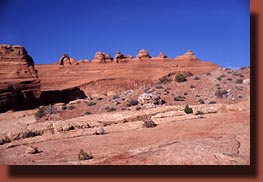 Too
tired to be enthusiastic about hiking, we elected to return to the motel
room not far away and snooze for a bit. When we awoke two or three hours
later, the sun was out and we naturally sped off to the park. Our first
stop was the Delicate Arch view point trail. From our vantage on top of
the small ridge ¾ mile away from the arch we could distinguish a
woman in a white wedding dress, presumably having wedding photos taken,
just next to the arch. As the afternoon waned, we cruised back to the Windows
Section where we were joined by an army of photographers gathering for
the sunset. The only people, out of all seen, not donning cameras were
two high-school aged hippies who were engaging in some sort of cane-drum/bell
and recorder jam session up by Turret Arch. Gave the place good atmosphere.
Andra and I initially walked through the sun-drenched field of bitterbrush
around to the backside of the Windows and the shade cast by the mammoth
rock walls. Moving slowly in Too
tired to be enthusiastic about hiking, we elected to return to the motel
room not far away and snooze for a bit. When we awoke two or three hours
later, the sun was out and we naturally sped off to the park. Our first
stop was the Delicate Arch view point trail. From our vantage on top of
the small ridge ¾ mile away from the arch we could distinguish a
woman in a white wedding dress, presumably having wedding photos taken,
just next to the arch. As the afternoon waned, we cruised back to the Windows
Section where we were joined by an army of photographers gathering for
the sunset. The only people, out of all seen, not donning cameras were
two high-school aged hippies who were engaging in some sort of cane-drum/bell
and recorder jam session up by Turret Arch. Gave the place good atmosphere.
Andra and I initially walked through the sun-drenched field of bitterbrush
around to the backside of the Windows and the shade cast by the mammoth
rock walls. Moving slowly in 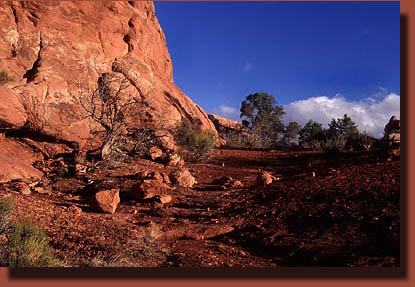 the
afternoon shade, we soaked in the visual delights of the sun lighting up
the Roan Cliffs and the Grand Mesa in Colorado. As the sun sunk down, I
too whipped out my camera and clicked away in the delightful dying light
of day. Andra sat on a stone block near the South Window, sniffling away
her cold in the chilly air, while I ranged over the sandstone blocks acquiring
photographs that will keep me from rash action during the long, dark winter
months of next year. As we walked back to the car after the sun was eclipsed
by the rim of the earth, I believe we may have walked straight into at
least 4 long-timed exposures of various arches. Rounding one particular
corner of Turret Arch we were confronted with a veritable firing squad
of Canon lenses pointed our way. I tried to hide my camera so I could pretend
I was not part of this voyeuristic group, and I also vowed to hike hardy
the following day to remind myself that I was here to hike, not photograph.
Photographs second. As we climbed in the car, I noted two men with large
camera-equipment packs and tripods walking straight across the cryptobiotic-covered
field back to their car, the
afternoon shade, we soaked in the visual delights of the sun lighting up
the Roan Cliffs and the Grand Mesa in Colorado. As the sun sunk down, I
too whipped out my camera and clicked away in the delightful dying light
of day. Andra sat on a stone block near the South Window, sniffling away
her cold in the chilly air, while I ranged over the sandstone blocks acquiring
photographs that will keep me from rash action during the long, dark winter
months of next year. As we walked back to the car after the sun was eclipsed
by the rim of the earth, I believe we may have walked straight into at
least 4 long-timed exposures of various arches. Rounding one particular
corner of Turret Arch we were confronted with a veritable firing squad
of Canon lenses pointed our way. I tried to hide my camera so I could pretend
I was not part of this voyeuristic group, and I also vowed to hike hardy
the following day to remind myself that I was here to hike, not photograph.
Photographs second. As we climbed in the car, I noted two men with large
camera-equipment packs and tripods walking straight across the cryptobiotic-covered
field back to their car, 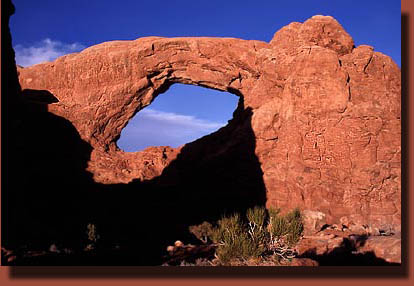 despite
the large sign at the trailhead explaining why this very action is hard
on the land. I wanted to point this out to them, explain casually to them
why it was bad and if that failed break a tripod leg, but I didnít. Lesson:
not all who can operate a camera can read. Or so it seems. despite
the large sign at the trailhead explaining why this very action is hard
on the land. I wanted to point this out to them, explain casually to them
why it was bad and if that failed break a tripod leg, but I didnít. Lesson:
not all who can operate a camera can read. Or so it seems.
On a related note, why is it that the Department
of Interiorís Park Service presents convincing and scientifically-correct
arguments for not walking on cryptobiotic soil, while the Department of
Interiorís Bureau of Land Management, operating just next door, sells (at
a financial loss) the right to ranchers to run their cattle to and fro
across this very same croyptobiotic soil. How can it be bad for a 200-lb
human to walk on the stuff when it is alright for a 900-lb steer to? Mixed
signals, as usual, from the government bureaucracy. No wonder people donít
take the Park Service signs seriously.
We motored back to The Virginian, and ate dinner
of crackers, cheese and summer sausage.
|